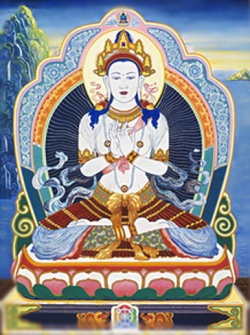Difference between revisions of "Five female buddhas"
| (4 intermediate revisions by one other user not shown) | |||
| Line 1: | Line 1: | ||
<noinclude>[[File:Ochana_298.jpg|thumb|250px|]]</noinclude> | <noinclude>[[File:Ochana_298.jpg|thumb|250px|]]</noinclude> | ||
| + | <poem> | ||
The [[five female buddhas]] of the [[five families]], also known as the [[five mothers]] ([[Wyl.]] ''[[yum lnga]]'') are: | The [[five female buddhas]] of the [[five families]], also known as the [[five mothers]] ([[Wyl.]] ''[[yum lnga]]'') are: | ||
| Line 8: | Line 9: | ||
#[[Samayatara]] (Skt.; Tib. {{BigTibetan|[[དམ་ཚིག་སྒྲོལ་མ་]]}}, ''[[Damtsik Drolma]]'') also known as [[Green Tara]], the [[consort]] of [[Amoghasiddhi]], who represents the [[purity]] of the [[element wind]] | #[[Samayatara]] (Skt.; Tib. {{BigTibetan|[[དམ་ཚིག་སྒྲོལ་མ་]]}}, ''[[Damtsik Drolma]]'') also known as [[Green Tara]], the [[consort]] of [[Amoghasiddhi]], who represents the [[purity]] of the [[element wind]] | ||
| − | The [[Five Female Buddhas]] are a set of figures [[visualized]] in [[meditation]]. They embody aspects of [[wisdom]], and through [[visualizing]] them and reciting their [[mantras]] gradually something of that [[wisdom]] ‘rubs off’. Most of these five figures have not played a very important role in the [[Buddhist tradition]]. They appear mainly in the [[tantric]] context as [[consorts]] of the five {{Wiki|male}} figures known as the [[Five Jinas]] (‘[[Conquerors]]’ – of [[suffering]]) or the [[Five Dhyani Buddhas]] (‘[[Buddhas]] of [[meditation]]’). | + | The [[Five Female Buddhas]] are a set of figures [[visualized]] in [[meditation]]. They embody aspects of [[wisdom]], and through [[visualizing]] them and reciting their [[mantras]] gradually something of that [[wisdom]] ‘rubs off’. Most of these five figures have not played a very important role in the [[Buddhist tradition]]. They appear mainly in the [[tantric]] context as [[consorts]] of the five {{Wiki|male}} figures known as the [[Five Jinas]] (‘[[Conquerors]]’ – of [[suffering]]) or the [[Five Dhyani Buddhas]] (‘[[Buddhas]] of [[meditation]]’). The [[sacred]] union [[Mandala]] of the [[Five Wisdom]] {{Wiki|Male}} and [[Female Buddhas]] is a [[representation]] of our [[mind]], when our [[mind]] is free from [[delusion]]. It is the union of our {{Wiki|male}} and {{Wiki|female}} sides in deep [[awareness]]. |
| − | + | In [[Tibetan Buddhism]] it is believed that [[enlightenment]] is obtained through the union of [[wisdom]] and [[compassion]]. The figures in a Yab Yum (father mother) [[Mandala]] are [[meditation]] tools, the {{Wiki|male}} [[deity]] representing [[compassion]], the {{Wiki|female}} representing [[wisdom]] ([[insight]]), and their balanced union an [[offering]] of [[compassion]] for the [[world]]. | |
| + | The process of contemplating and practicing with the [[five wisdom]] “fathers and mothers [[Buddhas]]” allows us to become grounded in a deeper [[knowledge]] of ourselves, our patterns and the workings of our [[consciousness]]. | ||
| + | </poem> | ||
<noinclude>{{RigpaWiki}} | <noinclude>{{RigpaWiki}} | ||
| − | [[Category:Five | + | [[Category:Five female Buddhas]] |
| − | </noinclude> | + | </noinclude>{{BuddhismbyNumber}} |
Latest revision as of 10:26, 22 April 2014
The five female buddhas of the five families, also known as the five mothers (Wyl. yum lnga) are:
- Dhatvishvari (Skt.; Tib. དབྱིངས་ཕྱུག་མ་, Ying Chukma) also known as Vajra Datvishvari or White Tara, the consort of Vairochana, who represents the purity of the element space
- Buddhalochana (Skt.; Tib. སངས་རྒྱས་སྤྱན་, Sangyé chenma) the consort of Akshobhya, who represents the purity of the element earth
- Mamaki (Skt.; Tib. མ་མ་ཀི་, Mamaki) the consort of Ratnasambhava, who represents the purity of the element water
- Pandaravasini (Skt.; Tib. གོས་དཀར་མོ་, Gökarmo) the consort of Amitabha, who represents the purity of the element fire
- Samayatara (Skt.; Tib. དམ་ཚིག་སྒྲོལ་མ་, Damtsik Drolma) also known as Green Tara, the consort of Amoghasiddhi, who represents the purity of the element wind
The Five Female Buddhas are a set of figures visualized in meditation. They embody aspects of wisdom, and through visualizing them and reciting their mantras gradually something of that wisdom ‘rubs off’. Most of these five figures have not played a very important role in the Buddhist tradition. They appear mainly in the tantric context as consorts of the five male figures known as the Five Jinas (‘Conquerors’ – of suffering) or the Five Dhyani Buddhas (‘Buddhas of meditation’). The sacred union Mandala of the Five Wisdom Male and Female Buddhas is a representation of our mind, when our mind is free from delusion. It is the union of our male and female sides in deep awareness.
In Tibetan Buddhism it is believed that enlightenment is obtained through the union of wisdom and compassion. The figures in a Yab Yum (father mother) Mandala are meditation tools, the male deity representing compassion, the female representing wisdom (insight), and their balanced union an offering of compassion for the world.
The process of contemplating and practicing with the five wisdom “fathers and mothers Buddhas” allows us to become grounded in a deeper knowledge of ourselves, our patterns and the workings of our consciousness.
